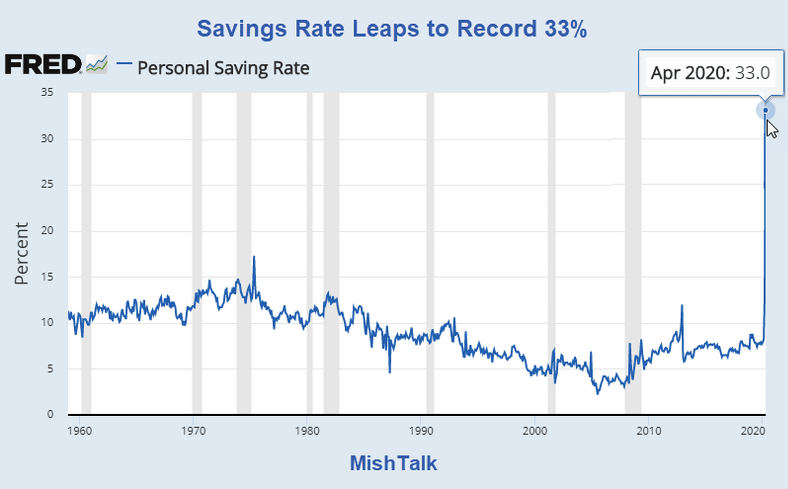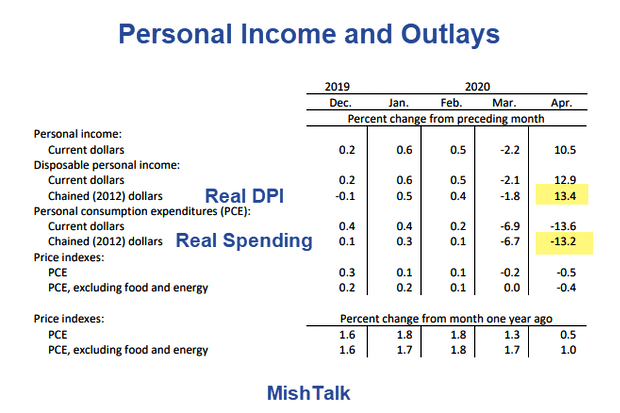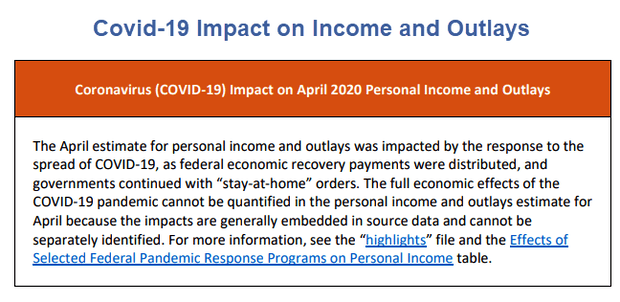Let's start with a table and statements from the BEA's Personal Income and Outlays report.
Personal Income and Outlays
Details
- Current disposable income rose 12.9% to $18.66 trillion.
- Current PCE fell 13.6% to $12.51 trillion.
- Savings = $18.66 Trillion - $12.51 trillion = $6.15 trillion
The personal saving rate is savings as a percentage of disposable personal income.
Savings Rate = ($6.15 / $18.66) * 100 = 33.0%
Cobid-19 Disclaimer
"The full economic effects of the COVID-19 pandemic cannot be quantified in the personal income and outlays estimate for April because the impacts are generally embedded in source data and cannot be separately identified."
Eight Things Impacting Savings
- Stimulus checks
- Forbearance Plans
- BEA Disclaimer and Imputations
- Work-From-Home
- Stores Closed
- Price Drops
- Deferred Medical Spending
- No Vacations
Income Surges as Spending Drops Most on Record
Let's fill in additional details, some from my report earlier today Income Surges as Spending Drops Most on Record
1: Stimulus Checks: The government sent stimulus checks for $1,200. These are a one time play and the effect will roll off. Check distribution was uneven. People received a check if they were below a certain income level whether or not they lost any income to Covid-19.
2: Forbearance Plans: Credit card companies, auto loan companies, rent companies, and mortgage companies all allowed consumers the right to skip payments if they requested. These amount will have to be made up later.
3: BEA Disclaimer: The BEA admits "impacts are generally embedded in source data and cannot be separately identified." That pertains to points one and two but there are also mortgage imputations as explained below.
4: Work-From-Home: Those working from home are not buying as much gasoline or eating out for lunch.
5: Stores Closed: Restaurants, bars, and general merchandise stores are closed. Services such as barbers and beauty salons are also closed.
6: Price Drops: Prices generally moved lower. Gasoline, plane tickets, and rental cars are standouts. Also some insurance companies voluntarily dropped rates as people are driving less.
7: Deferred Medical Spending: Elective medical and dental procedures were halted.
8: No Vacations: Obvious impacts on hotels, air travel, call rentals, restaurants.
Rent vs Mortgages
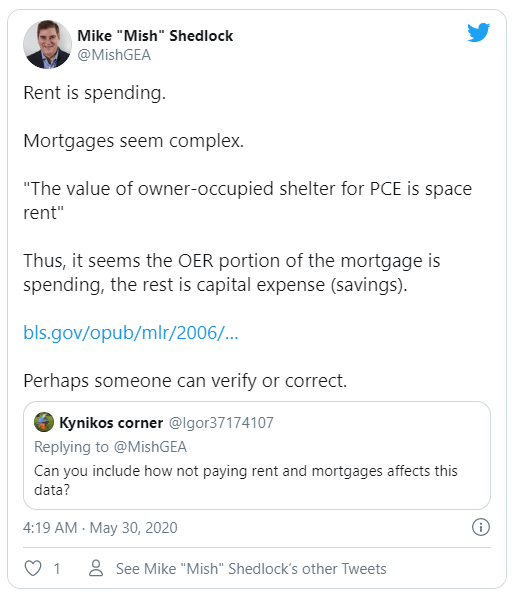
How did Mortgages Impact the Savings Rate?
Mortgage forbearance plans differ from credit cards, auto loans, and rent skip-a-pay plans.
The BLS article CE and the PCE Comparison explains:
In CE publications, owner-occupied shelter expenditures are defined to include mortgage interest and charges, property taxes, maintenance and repairs, insurance, and other related costs.
In contrast, the BEA defines the value of owner-occupied shelter for PCE as space rent, which excludes charges for utilities, major appliances, furniture, and furnishings.
The BEA has this blurb on the PCE Price Index which also ties back to the CPI.
The PCE market-based price index excludes most imputed expenditures, such as “financial services furnished without payment,” for which deflators are implicit, based on independent current dollar and chained-dollar estimates.
However, it includes “imputed rental of owner-occupied nonfarm housing,” which is deflated by the CPI for owner’s equivalent rent, so that the index will be comparable with the overall CPI.
These articles imply that the BEA considers the imputed Owners' Equivalent Rent (OER) as a PCE expense but not the rest of the mortgage payment which is a capital expense and thus savings.
If so, the amusing result is that the capital expense portion of the mortgage, whether skipped or paid, contributes to savings.
However, the OER portion of the mortgage payment distorted savings upward (as did skipped rent, auto loan, credit card, and skipped payments in general).
In Regards to Point 3
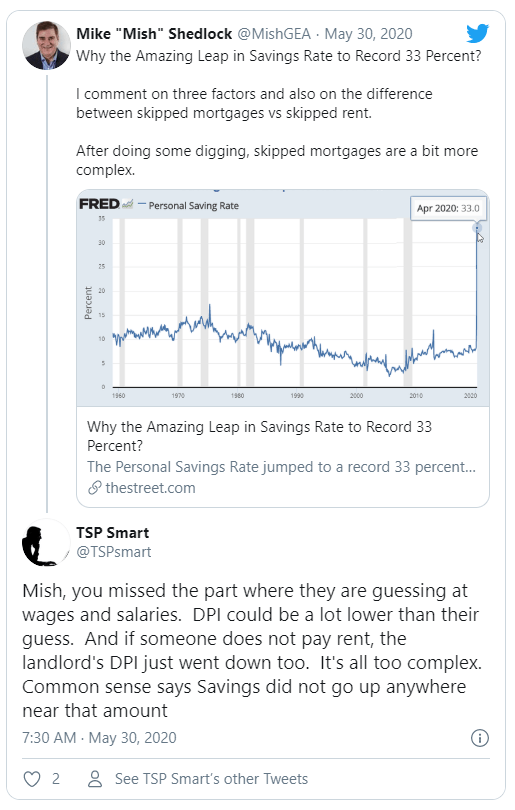
Panic Sets In
Please recall Panic Sets In: Fed Promotes More Free Money
The Fed seldom mentions actions that Congress needs to take. Yet, we have back-to-back messages from Powell and Kashkari on the need for free more free money from Congress.
The Fed is very worried about skipped payments and the stock market both.
At Least for a While, It Pays Better to Be Unemployed
In regards to stimulus checks, At Least for a While, It Pays Better to Be Unemployed.
Results will vary greatly.
Rebound
A spending rebound is coming up, but it will not take things back to what they were before Covid-19 hit.
This material is based upon information that Sitka Pacific Capital Management considers reliable and endeavors to keep current, Sitka Pacific Capital Management does not assure that this material is accurate, current or complete, and it should not be relied upon as such.
Recommended Content
Editors’ Picks
EUR/USD edges lower toward 1.0700 post-US PCE

EUR/USD stays under modest bearish pressure but manages to hold above 1.0700 in the American session on Friday. The US Dollar (USD) gathers strength against its rivals after the stronger-than-forecast PCE inflation data, not allowing the pair to gain traction.
GBP/USD retreats to 1.2500 on renewed USD strength

GBP/USD lost its traction and turned negative on the day near 1.2500. Following the stronger-than-expected PCE inflation readings from the US, the USD stays resilient and makes it difficult for the pair to gather recovery momentum.
Gold struggles to hold above $2,350 following US inflation

Gold turned south and declined toward $2,340, erasing a large portion of its daily gains, as the USD benefited from PCE inflation data. The benchmark 10-year US yield, however, stays in negative territory and helps XAU/USD limit its losses.
Bitcoin Weekly Forecast: BTC’s next breakout could propel it to $80,000 Premium

Bitcoin’s recent price consolidation could be nearing its end as technical indicators and on-chain metrics suggest a potential upward breakout. However, this move would not be straightforward and could punish impatient investors.
Week ahead – Hawkish risk as Fed and NFP on tap, Eurozone data eyed too

Fed meets on Wednesday as US inflation stays elevated. Will Friday’s jobs report bring relief or more angst for the markets? Eurozone flash GDP and CPI numbers in focus for the Euro.
